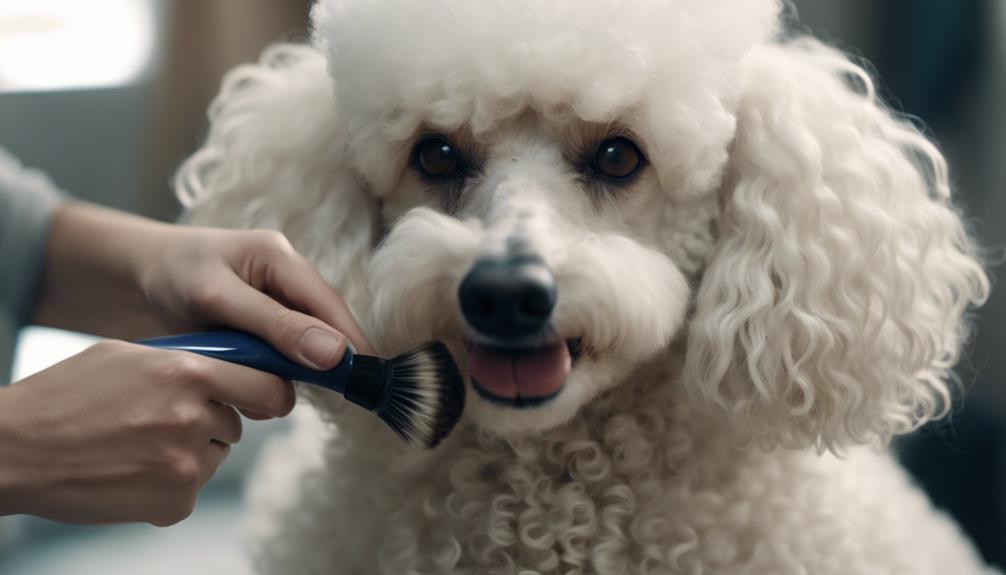When approaching the art of brushing poodle coats, remember that the key lies in finesse rather than force. You may have the tools and the intention, but mastering the technique is where the magic happens. So, how can you ensure your poodle's coat remains luscious and mat-free? Let's explore the subtle nuances that can transform a grooming session from a chore to a bonding experience that benefits both you and your fluffy companion.
Key Takeaways
- Proper brushing techniques are crucial for maintaining different poodle coat types.
- Regular brushing prevents matting and promotes a healthy, shiny coat.
- Selecting the right brush and frequency based on coat type is essential.
- Professional grooming aids in intricate tasks and overall coat health care.
Understanding Poodle Coat Types
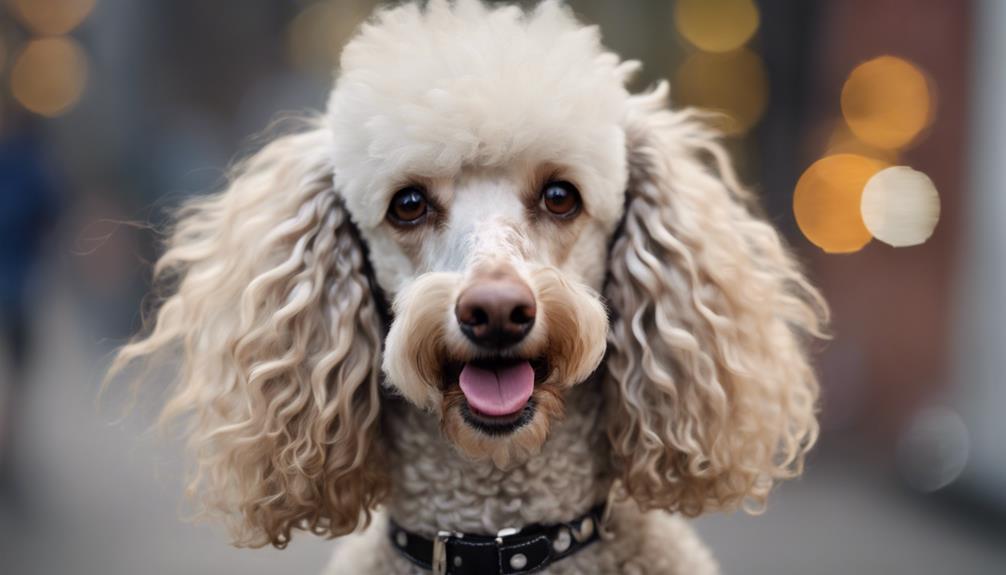
To properly groom your Poodle, it is essential to first understand the various coat types they can have, including curly, corded, and wavy coats, each requiring specific grooming techniques and maintenance. Curly coats are among the most common in Poodles and necessitate regular detangling and clipping to prevent matting. These coats have tight curls that can easily tangle, so using a slicker brush or a metal comb is recommended to keep the curls free of mats. When brushing a curly coat, it is important to start from the bottom and work your way up to prevent pulling on the hair and causing discomfort to your Poodle. Regular grooming sessions for curly coats are crucial to maintaining their appearance and overall health. By understanding the nature of curly coats and implementing the appropriate grooming practices, you can ensure that your Poodle's coat remains healthy, shiny, and free of mats.
Proper Brush Selection
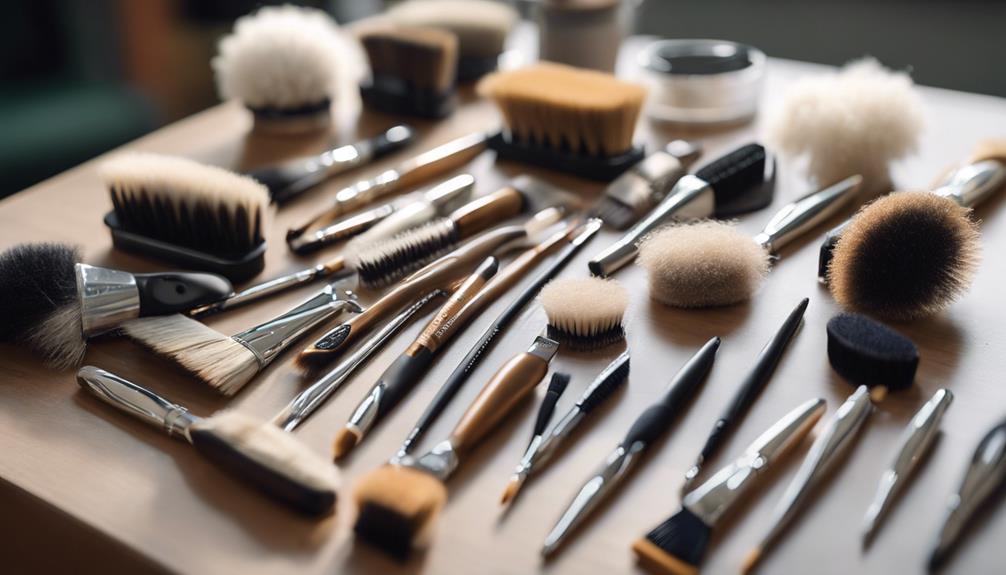
When selecting a brush for your poodle, consider the bristle type, coat length, and whether to use a comb or a slicker brush. Soft pin brushes are gentle for regular brushing, while slicker brushes can be cautiously utilized for detangling and mat removal. Ensure the brush is suitable for your poodle's coat type and sensitivity by testing it on your forearm before regular use.
Brush Bristle Types
Selecting the appropriate bristle type is essential in ensuring effective grooming for your poodle's coat. For gentle daily brushing and mat prevention, opt for a pin brush with soft bristles. If your poodle has curly fur with tangles and mats, a slicker brush with fine wire bristles is ideal for removal. When finishing and smoothing the coat, consider using bristle brushes with nylon or natural bristles. Remember, the bristle type should align with your poodle's coat texture and grooming requirements for the best results. Proper brush selection plays a significant role in maintaining the health, appearance, and comfort of your poodle's coat during grooming sessions. Choose wisely to keep your furry companion looking and feeling their best.
Coat Length Consideration
Consider the coat length of your poodle when choosing the appropriate brush for grooming to ensure optimal results. Long-coated poodles benefit from using a slicker brush to prevent knots and mats, while short-coated poodles do well with a soft bristle pin brush for gentle dirt removal. Selecting the right brush based on the length of your poodle's coat is crucial for effective grooming. Proper brush selection plays a significant role in maintaining a healthy and tangle-free fur, contributing to your poodle's overall well-being. By understanding the coat length consideration, you can choose the right grooming tool, such as a slicker brush, to keep your poodle's coat in top condition.
- Long-coated poodles benefit from a slicker brush
- Short-coated poodles should use a soft bristle pin brush
- Choosing the right brush ensures effective grooming
- Proper brush selection maintains a healthy fur
- Slicker brushes help prevent knots and mats
Comb Vs. Slicker
For optimal grooming results for your poodle's coat, understanding the difference between using a comb and a slicker brush is essential. Slicker brushes are perfect for gently removing tangles and mats in poodle coats due to their fine wire bristles that reach deep into the fur. On the other hand, combs are better suited for detangling and smoothing out the coat, making them ideal for those finishing touches to achieve a sleek appearance. When choosing between a comb and a slicker brush, consider the specific grooming needs of your poodle's coat to ensure gentle brushing that maintains the coat's health and aesthetics. Remember, a gentle approach with the right tool can make a significant difference in your poodle's grooming routine.
Sectioning Techniques for Brushing
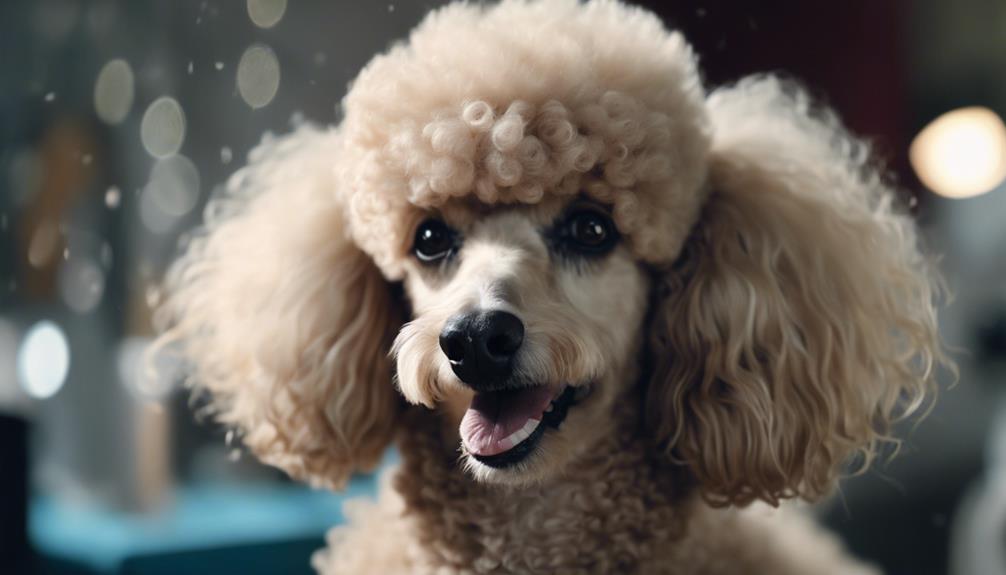
When grooming your poodle's coat, employing sectioning techniques is crucial for thorough and effective brushing. By dividing the coat into manageable parts, you ensure that every area is properly attended to, preventing tangles and matting. Here are some tips to help you master sectioning techniques:
- Start by dividing the coat into small sections using clips or hair ties.
- Work methodically from one section to another to ensure complete coverage.
- Focus on one section at a time, brushing from the roots to the tips.
- Use a slicker brush or a comb designed for your poodle's coat type.
- Take your time with each section, making sure to remove any tangles gently.
Importance of Gentle Detangling
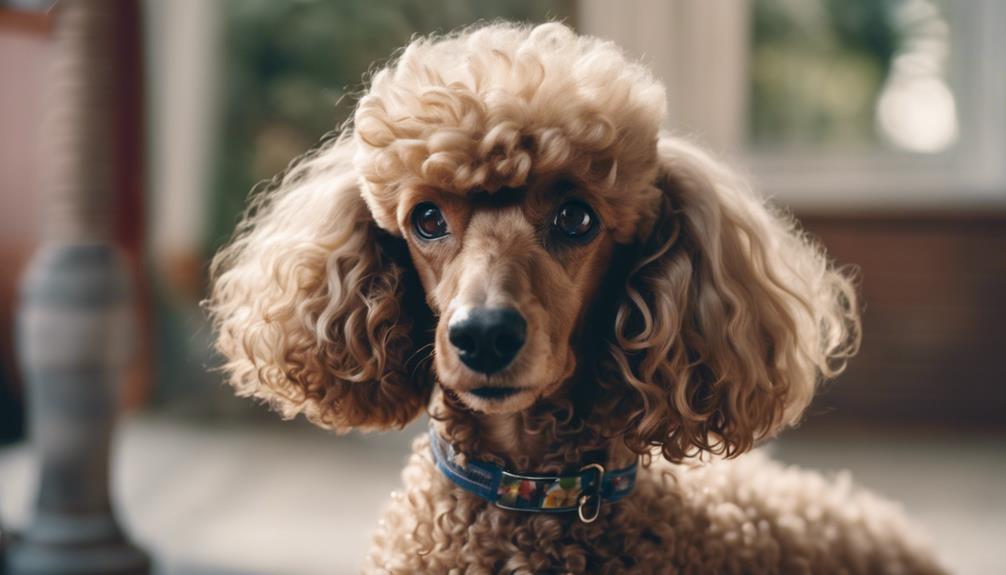
To maintain your poodle's coat health and comfort during grooming, prioritizing gentle detangling is essential. When detangling your poodle's coat, make sure to use a wide-tooth comb or slicker brush to minimize pulling and tugging on knots. Starting from the ends and working your way up to the roots will help avoid causing pain to your furry friend. Regular detangling sessions not only reduce mats but also keep the coat healthy and shiny. Proper detangling techniques ensure a stress-free grooming experience for your poodle, promoting a strong bond between you and your pet.
| Gentle Detangling Tips | Benefits |
|---|---|
| Use wide-tooth comb or slicker brush | Minimizes pulling and tugging on knots |
| Start from ends, work up to roots | Avoids causing pain |
| Regular sessions | Reduce mats, keep coat healthy and shiny |
Tips for Brushing Sensitive Areas

As you move on to focusing on brushing sensitive areas of your poodle, remember the importance of using a gentle slicker brush for delicate regions like the face, ears, and underbelly. When dealing with these sensitive areas, it's crucial to approach them with care to prevent any discomfort or pain for your furry friend. Here are some tips to help you with brushing these sensitive areas:
- Brush in the direction of hair growth to prevent tugging or pulling on delicate skin.
- Take your time and be patient when brushing sensitive areas to build trust with your poodle.
- Use short, gentle strokes to avoid any unnecessary pulling on the skin.
- Regularly check for any signs of irritation or redness in sensitive areas while grooming your poodle.
- Reward your poodle with treats or praise after brushing sensitive areas to create a positive association with grooming sessions.
Frequency of Brushing Sessions
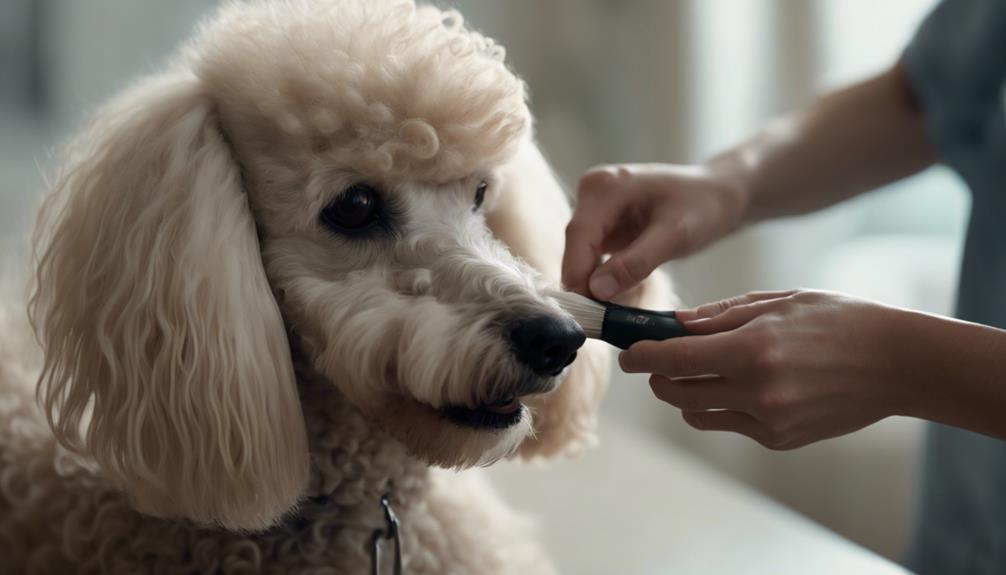
You must consider the ideal brushing schedule for your poodle's coat maintenance. Regular brushing sessions are vital to prevent matting and keep the coat healthy and shiny. Factors like coat type, activity level, and the dog's overall health should influence how often you brush your poodle.
Brushing Session Frequency
Regularly brushing your poodle's curly coat every 1-3 days is crucial to prevent matting and maintain a healthy, shiny appearance. Consistent grooming not only keeps your poodle looking great but also contributes to their overall well-being. Here are some tips to help you enjoy the brushing sessions:
- Start by gently combing out any tangles before brushing.
- Use a slicker brush or a comb designed for curly coats to prevent damage.
- Divide your brushing sessions into shorter periods for better cooperation.
- Reward your poodle with treats or praise to create a positive association with brushing.
- Pay attention to areas like behind the ears, under the legs, and around the tail where mats commonly form.
Ideal Brushing Schedule
Brush your poodle's curly fur at least 3-5 times a week to prevent matting and maintain a healthy coat. Consistent brushing helps distribute natural oils, keeping the coat shiny and free of tangles. The frequency of brushing sessions can depend on your poodle's lifestyle and activity level. Show poodles, for instance, may require daily brushing to uphold their impeccable appearance. Adjust the brushing schedule according to your poodle's specific coat length, texture, and grooming requirements. Here's a table summarizing the ideal brushing schedule for poodles:
| Poodle Type | Ideal Brushing Frequency |
|---|---|
| Curly Coated | 3-5 times a week |
| Show Poodles | Daily brushing |
| Active Poodles | More frequent brushing based on activity level |
| Pet Poodles | 3-5 times a week |
Maintaining Coat Health With Brushing
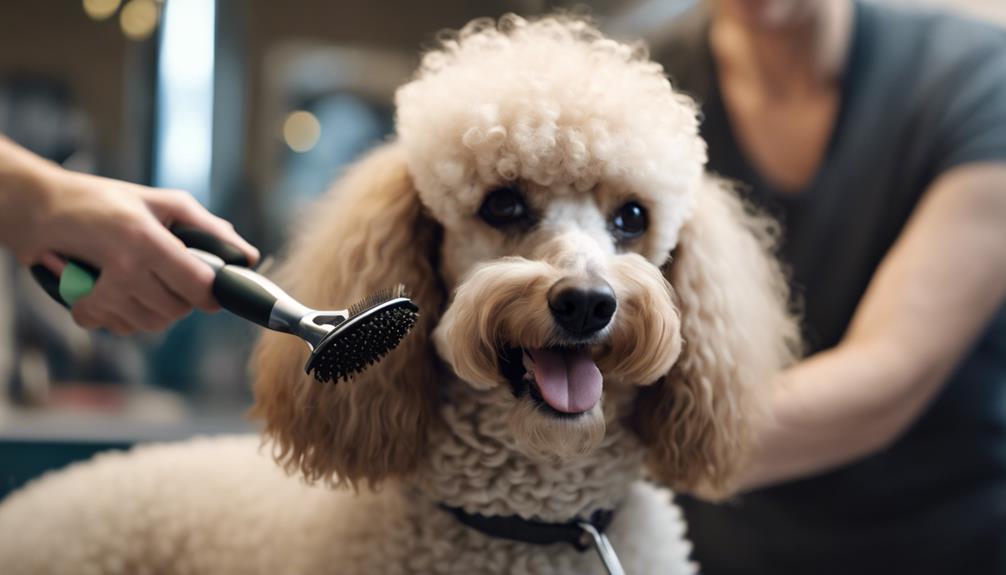
Maintaining optimal coat health through consistent brushing is essential for poodle owners. Regular brushing not only prevents matting and tangling in poodle coats but also stimulates the natural oils, promoting a healthy and shiny coat. Proper brushing is crucial as it helps remove dirt and debris, preventing skin issues. Additionally, consistent brushing plays a vital role in the early detection of any skin abnormalities that may arise. Moreover, the bonding time created during brushing sessions provides relaxation for both poodles and owners.
- Regular brushing prevents matting and tangling in poodle coats.
- Brushing stimulates natural oils, promoting a healthy and shiny coat.
- Proper brushing removes dirt and debris, avoiding skin issues.
- Consistent brushing aids in early detection of skin abnormalities.
- Brushing creates bonding time and relaxation for poodles and owners.
Frequently Asked Questions
How Do You Brush a Poodle Coat?
You brush a poodle coat by starting from the ends and working your way up with a slicker brush or metal comb. Brush in the direction of hair growth to prevent tugging and discomfort. Regular brushing ensures coat health and prevents matting.
Is It Better to Brush a Poodle Wet or Dry?
You should always brush your poodle's coat when it's dry. Wet hair is prone to breakage and damage, while dry brushing helps maintain fur integrity, prevents tangles, and ensures optimal results. Remember, wait for complete dryness for effective brushing.
How Do Groomers Get Poodles so Fluffy?
To achieve fluffy poodle coats, groomers use high-quality towels, dabbing and blotting techniques, and ionic dryers for faster drying. Brushing in small sections with finishing spray and a slicker brush ensures a fluffy finish.
How Often Should I Brush My Poodles Hair?
You should brush your poodle's hair regularly to prevent matting and promote a healthy coat. Brushing frequency depends on your poodle's activity level and coat length. It's essential for maintaining a shiny, tangle-free coat and spotting any skin issues early.
Conclusion
In conclusion, proper brushing techniques are crucial for maintaining the health and appearance of your poodle's coat. By understanding your poodle's specific coat type, using the right tools, and implementing gentle brushing techniques, you can prevent matting and skin infections. For example, Sarah noticed a significant improvement in her poodle's coat health and overall demeanor after switching to a regular brushing routine tailored to her pup's needs. Remember, regular grooming leads to a happy and healthy poodle!
